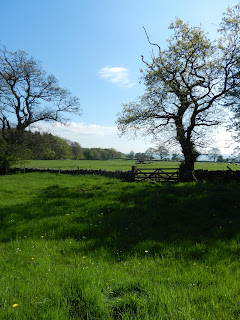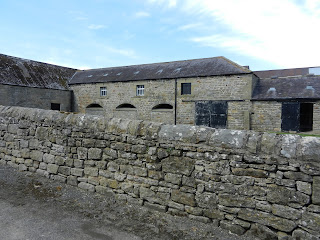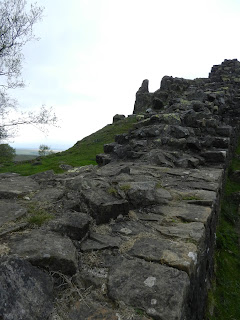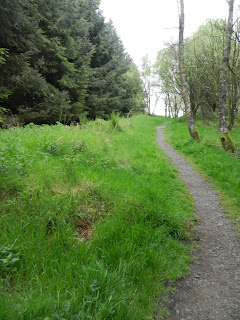[Note: photos, and probably revisions, to come]
Grey and windy again,and verging on fog, but not as cold. Back up the lee of the crags, this time on the intended path. Even though we've skipped over the highest 1-2 miles of the Path itself, we're still on track to walk all the way across England, and there were plenty more crags to come. Today's was probably the most spectacular of the Wall walk scenery--extended stretches of exposed Wall, steep crags, distant views, Sycamore Gap (the eponymous tree plays a bit part in Kevin Costner's Robin Hood Prince of Thieves. The tree and its setting are a lot more attractive than the movie). As we began our first crag climb after returning to the Path proper, we heard a sound like a flock of migrating geese. But no--it was a flock of middle schoolers cresting the bend. We found sturdy rocks to perch on just off the path to let them by. Teacher in front, marching briskly; 4 chaperoning Mums at the rear, barking at stragglers like sheepdogs. The kids' conversation was amusingly familiar--all giggles and bravado and excited moaning about the climb. Twig-legged girls in skinny jeans snapping photos with their pink cell phones, rough-housing boys with untied boot laces dragging under their own and their neighbors' feet, inches from the precipice edge. It never ceases to amaze me that any of us survive to adulthood.
I thought yesterday's wind was whipping--this morning's was strong enough at times to threaten balance on the rocky downhill slopes and at crag crests. As with yesterday, there were a few fitful spittings of light rain, but it seemed to start in earnest just before Sycamore Gap--a steep drop down and back up with a large sycamore tree right at the crest of the gap--the only tree that high up anywhere in sight--and a rather handsome tree at that. Pop had been pretty worried about being up on the crags in rain, as the rocks apparently get quite slippery. I had started the day in rain gear, but Pop hadn't, so we stopped to wrestle gear in the wind and rain, and I put away my camera, not remembering how water resistant it is supposed to be. Mercifully the rain only lasted 15-20 minutes and the rocks didn't get wet enough to be truly slippery. But the wind continued, and I wanted so to let my hair loose to whip around, but knew I wouldn't be able to corral it again if I did.
The most beautiful stretch came just after Sycamore Gap, where the line of the Wall traces the edge of Highshield Crags above Crag Lough. No actual need for a human-built Wall here--the crag face is beyond formidable--sheer and high. Jackdaws played in the wind below our feet--whizzing from one end of the lough to the other, high in the air--sometimes gliding with wings outstretched, sometimes hurtling like torpedoes with wings pulled back tight, occasionally hitting a pocket of turbulence and somersaulting violently, though without losing much altitude. Perhaps I anthropomorphize, but it looked like playing--flying just for the sheer joy of movement.
Once again, the endless steep up and down of the crags was pretty hard on Pop. We came to an unmarked fork in the path--he wanted to try the lower path, and I the higher, though we weren't sure which was the official one. As we puzzled, a wiry hiker with a spiky orange crew cut, giant backpack, and walking poles tromped up. She consulted her GPS but didn't have any better idea than we, but she was much more decisive and plowed on ahead along the lower path. Pop and I decided to try taking separate routes again. I took the high road and he took the low road, and he was at Housesteads afore me. But I got to plow up and down a few crags at speed and really get my blood pounding. Housesteads is an impressive fort, and its extent is clearly not fully exposed, as the surrounding grassy hillside is crowded with linear lumps. But, as Pop said, it felt very much like a case of "if you've seen one, you've seen them all." (I know that really isn't the case--the archaeology and history can be fascinating puzzles if you delve far enough in to begin to understand the details, but Roman history has never really grabbed me).
After Housesteads, the crags were much less craggy and steep, but the ups and downs were just as high--so very long and seemingly endless. And we lost the Path for the first time--missed a turn in a place it should have been fairly clear. Mercifully we realized that fairly quickly when we reached a corner where our choices going forward were between a locked and rusted gate or a steep cow-churned drop into a stream called Knag Burn (Knag Burn Mire would have been more accurate).
The wish to let my hair out kept nagging, so I eventually did so. I'm sure I looked Medusa in sunglasses, or perhaps better, given the location, one of Macbeth's hags, but it felt glorious, whipping around as we walked,. Probably best that I waited until we were past the steepest of the crags, as it would have made negotiating the rocks more difficult.
The up and down gradually subsided and settled into rather bleak marshland running beside the highway. For a stretch, the Wall appeared to be buried under the highway, as all that was visible was the Vallum (a defensive ditch dug parallel to the Wall on its north side). The marsh was full of bird song, but I couldn't see any birds, even with my binoculars. Toward the end of our walking today, the Wall re-emerged from the ground here and there. It's actually kind of eerie how it is sometimes a solid, even massive presence, sometimes a shrouded creeping line, sometimes only hinted at by its shadowing ditches, and sometimes vanishes altogether. Often I find myself wondering--is that a bit of the Wall, or just a modern wall? But I think not an easy question to answer perhaps, since many of the modern field walls contain stones repurposed from the Roman Wall.
We were supposed to get to Chollerford today, but we also needed to be done by 5:30, as the vaguaries of B&B availability have us staying at the same place two nights in a row, and our hostess needed to collect us and drive us back to home base before 6. So tomorrow morning she will drop us off where we left off tonight. We should be able to stay on track, as tomorrow was scheduled as a 7 mile walk; now we'll have to manage 9 instead. Last night's dinner at the Twice Brewed Inn was decent, but not remarkable; tonight's was far better--a shepherd's pie with very young and tender lamb and bits of carrot and onion in a rich brown gravy under an exquisitely fluffy mound of mashed potatoes topped with cheddar cheese. Sides of braised carrots and red cabbage dotted with raisins. Another round of Guinness and sticky toffee pudding with warm custard for dessert. I didn't intentionally plan for this to be a foodie vacation, as I didn't think that would amuse Pop, but the eating is turning out to be much better than I expected.

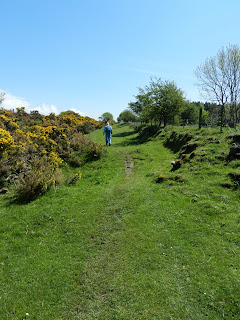
 Here (above right) the Wall peeks a shoulder out from under the modern road, and gorse masses in the Vallum alongside
Here (above right) the Wall peeks a shoulder out from under the modern road, and gorse masses in the Vallum alongside 















